| Microscopical
Society of Southern California
History
|
The Microscopical Society of Southern California. (MSSC) was founded in 1937 and dedicated to the study and practice of the science, art, and history of microscopy and to the collection and study of related scientific devices. We must thank our current president, James D. Solliday, for the detailed account of the early history of the society as given below (the full version of this article is printed in the MSSC Journal V8No1 Jan/Feb 2003 and V8No2 Mar/Apr 2003 which is available to paying members).
QUICKLINKS
 For
more than half a century, the Microscopical Society of Southern California has
provided the opportunity for both the scientist and the amateur to share in
their enthusiasm for the microscope.
For
more than half a century, the Microscopical Society of Southern California has
provided the opportunity for both the scientist and the amateur to share in
their enthusiasm for the microscope.
Mr. William Sokol was one of the earliest members of the Society. In March of 1980, at the suggestion of then president, Gil Melle, Mr. Sokol recorded his recollections of the formation and early history of the Society. He also preserved a number of originals documents and early photographs illustrating the activities and equipment used by founding members. According to these records the Society was formally organized on March 6, 1941. The original name was established as the “Los Angeles Microscopical Society.” However, many of the founding members were from areas surrounding Los Angeles, so on May 15, 1941, just two months later, the name was changed to the “Southern California Microscopical Society.” The following historical account has been recorded as experienced through the participation of early members such as Mr. Sokol. This account is intended to document the early history only and is therefore limited to the first twenty-eight years, ending with the official termination of the name “Southern California Microscopical Society.”
Shortly after the availability of the achromatic microscope (circa 1830’s), gentlemen with an interest in microscopy began gathering together for the purpose of promoting and further developing the microscope. The social impact of this most important instrument was first felt in England and Europe, but soon found its way to America. By the late 1860’s, American clubs and societies dedicated to the microscope began to surface. The San Francisco Microscopical Society has the distinction of being the first such organization on the West Coast. Established in 1870, it grew in size and reputation to such a degree that it attracted such prestigious visitors as Joseph Beck of London. However, after the great earthquake of 1906, the San Francisco Society was allowed to decline into obscurity. For the next few decades, activities in California associated with the microscope were left almost exclusively in the hands of its academic community.
Throughout the 1930’s, economic and social difficulties stimulated a new migration of people to the West where opportunity was somewhat brighter than the older, more established East Coast. California was beginning to grow and had established itself as the entertainment capital of the world. Educators, scientists and medical men were in great need and began choosing California as their new home. All of this created a greater demand for the microscope and the need to make it more commercially available. The West Coast was now able to support a number of new businesses that specialized in supplying optical instruments, including microscopes and their accessories. As one might expect, it was the men who were interested in the microscope that set themselves up in the business of repairing and selling the instrument. A number of these same gentlemen were responsible for establishing the Southern California Microscopical Society.
 Probably
the man who started it all was a gentleman named Max Erb
who at the time worked for the firm of Carl Zeiss. Max Erb was an enthusiastic
fellow who enjoyed the microscope and sought out other individuals who shared
his interests. One such individual was a machinist named Milton Gray who later
joined in partnership with Max Erb, establishing the firm of Erb & Gray
Instrument Co. However, long before this enterprise was to be born, Max Erb
had brought together an association of gentlemen that became known as “The
Microscope Group.” According to early records, the original founding members
were Max Erb, James Smith, Arthur Hurt
and Edward T. Lowe, to be joined later by Milton Gray.
Probably
the man who started it all was a gentleman named Max Erb
who at the time worked for the firm of Carl Zeiss. Max Erb was an enthusiastic
fellow who enjoyed the microscope and sought out other individuals who shared
his interests. One such individual was a machinist named Milton Gray who later
joined in partnership with Max Erb, establishing the firm of Erb & Gray
Instrument Co. However, long before this enterprise was to be born, Max Erb
had brought together an association of gentlemen that became known as “The
Microscope Group.” According to early records, the original founding members
were Max Erb, James Smith, Arthur Hurt
and Edward T. Lowe, to be joined later by Milton Gray.
 All
of these gentlemen considered microscopy to be their avocation and with some
it was also their vocation. It seems that, in addition to the microscope, these
men shared an interest in the game of chess. A chess tournament was a good excuse
to get together and cultivate their fellowship. Reading through Mr. Sokol’s
notes, I found that the early meetings alternated between microscopy and chess!
All
of these gentlemen considered microscopy to be their avocation and with some
it was also their vocation. It seems that, in addition to the microscope, these
men shared an interest in the game of chess. A chess tournament was a good excuse
to get together and cultivate their fellowship. Reading through Mr. Sokol’s
notes, I found that the early meetings alternated between microscopy and chess!
In the beginning most of the meetings were conducted at the homes of the members. The first meeting of the group was held sometime late in 1937. Because Max Erb was responsible for the formation of the Microscope Group, the duties of the President and Secretary were also assumed by him. This service is implied as he organized the meetings and made the phone calls that brought the group together. We shall therefore refer to him as the first acting officer and unofficial President of the Society.
1941
After a few years of acquiring equipment and hosting various meetings, the group
decided it was about time to establish a formal Society and conduct regular
meetings. A plan of how to proceed was needed as well as a set of proper bylaws.
The first meeting was set up at 12:00 noon on March 6, 1941, at Levy’s
restaurant. Present were the original members including Max Erb, James Smith
and Arthur Hurt. Arthur Hurt acting as the first Secretary faithfully recorded
in type-written form the proceedings of the meeting. Without any objection the
name of the organization was established as the Los Angeles Microscopical Society
(LAMS).
 A
few weeks later, on March 27th, a meeting was held at the residence of Dr. John
W. Budd. This meeting was occupied with activities of a technical nature. The
principles of illumination were discussed as well as a demonstration of Dr.
Budd’s equipment. German literature on the subject was translated and
provided by Max Erb. On April 24th, the Society convened at the Hematology Department
of Children’s Hospital. This meeting was devoted to the use and application
of the fluorescence microscope.
A
few weeks later, on March 27th, a meeting was held at the residence of Dr. John
W. Budd. This meeting was occupied with activities of a technical nature. The
principles of illumination were discussed as well as a demonstration of Dr.
Budd’s equipment. German literature on the subject was translated and
provided by Max Erb. On April 24th, the Society convened at the Hematology Department
of Children’s Hospital. This meeting was devoted to the use and application
of the fluorescence microscope.
The next meeting was also held at Children’s Hospital and took place on May 15, 1941. On this date the name of the Society was formally changed to the Southern California Microscopical Society (SCMS). The first books for the library were acquired courtesy of Max Erb. The books received were as follows: The Microscope., Journal of the Biological Photographic Association and Spencer Lens Company’s The Effective Use and Proper Care of the Microscope.
In June of 1941, an executive committee was established, and the following members were appointed to the committee: Dr. John W. Budd., Max A. Erb., Major Arthur C. Hurt, Jr., and James Smith. From this committee, the Society’s first officers were elected, as follows: Mr. James Smith, President; Mr. Max Erb, Vice-President; and Major Arthur C. Hurt, Jr., Secretary-Treasurer. Upon motion duly made, seconded and carried, an annual membership fee was fixed in the sum of $3. At the conclusion of this historic meeting the members adjourned from Children’s Hospital and gathered at the home of Mr. Siegfried Rumann. Mr. Rumann presented a motion picture of living protozoa and active Spirochaeta pallida cinemicrographed using darkfield illumination. The host demonstrated his equipment and laboratory techniques. At the time Mr. Rumann also worked as a character actor in many of the Marx Brothers movies.
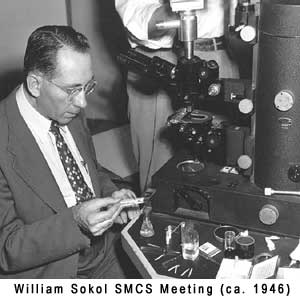 1946
1946
After entry of the United States into World War II, the Society voluntarily
curtailed most of its activities. There is some indication that among certain
individuals work may have continued, especially for members associated with
the Biological Photographic Association. However, the records clearly indicate
that the Society was temporarily inactivated.
Early in 1946 the officers began efforts to energize the members and expand the roll of the Society within the local scientific community. On February 28, 1946, the Secretary, Major Arthur C. Hurt, Jr., sent a letter to Dr. John A. Comstock, Associate Director of the Science Museum at Exposition Park, of the Los Angeles County Museum. This letter was the first step taken by the executive committee to “revitalize the Society.”
On the evening of May 15, 1946, at 7:00pm, The Southern California Microscopical Society held a meeting at the Los Angeles Athletic Club where the future of the organization would be discussed. The President, Mr. James Smith, presided and called the meeting to order. A summary of the purposes and goals of the Society were outlined. Major Hurt reported that the officers of the Society had contacted the L.A. County Museum and that a request to become affiliated with it had been favorably approved. This new relationship provided a permanent base of operation in which the Society could work and grow. It was decided that meetings would be held quarterly at the L.A. County Museum and that the intervening meetings would be held at the homes or in the laboratories of the members or at such places as might be designated by the officers. The following members were given the responsibility of providing regular reports on a pre-selected group of publications:
Mr. Milton Gray suggested the establishment of a card index of published materials on microscopy. He volunteered to prepare such an index for the year of 1946.
A number of regular meetings were held throughout the rest of 1946. This included a June meeting at the forensic laboratory of Mr. William W. Harper. The July meeting was held at the Los Angeles Tumor Institute and the August meeting at the Research Lab of the Union Oil Company of California at which Dr. Merrill and Dr. Naylor demonstrated the electron microscope. In September the Society met at the Photographic Dept of the Los Angeles County General Hospital. For the next few years this would become the most frequent alternative meeting place after the Museum.
The last meeting for the year was held at the home of the President, Mr. James Smith. By this time, the details for using the Museum had been worked out and the officers were able to bring before the Society a meeting schedule. It was decided that the Society should hold a regular meeting at the L.A. County Museum every second month, commencing in January of 1947, and that special meetings at alternative locations should be called whenever desirable. In preparation for the first meeting at the Museum it was decided that each member should provide an exhibit illustrating his or her area of interest.
1947
The first meeting at the County Museum took place on January 28, 1947. The meeting
was presided and called to order by Mr. James Smith. The content of the meeting
comprised the presentation of prearranged exhibits and photomicrographic illustrations.
Examples would include a series of 2x2 color slides on Ansco film by Mr. Smith,
featuring the mineral micro-mounts displayed by Mr. William Oke. Dr. John Budd
presented a series of color prints of cancer lesions, in the various phases,
before, during and after treatment. Mr. Edward Lowe and Major Arthur C. Hurt,
Jr., also displayed a series of photographs as well as the vertical photomicrographic
bench used in the process. The first meeting at the Museum was adjourned with
a vote of thanks to Dr. John Comstock for his courtesy in arranging a permanent
meeting place for the Society.
 Along
with the convenience of having a secure new home, the Society had been growing
quite rapidly. The documented account of the March 25th meeting is recorded
on no less than three pages. The second meeting held at the Museum held a ballot
for new officers for the coming year and Major Arthur C. Hurt, Jr., was elected
President.
Along
with the convenience of having a secure new home, the Society had been growing
quite rapidly. The documented account of the March 25th meeting is recorded
on no less than three pages. The second meeting held at the Museum held a ballot
for new officers for the coming year and Major Arthur C. Hurt, Jr., was elected
President.
The new President then presided over the election of Dr. John W. Budd as the new Vice-President and Mr. Max Erb as the new Secretary-Treasurer. Also of significance at this meeting was the election of the Society’s first Honorary Member. Upon motion duly made and carried, Dr. John A. Comstock was awarded the status of honorary membership. Throughout the rest of the year 1947 the meetings were held at the regular intervals established by the committee.
Before the new year arrived it was proposed by Mr. William Sokol that the Society sponsor its first annual exhibition. This exhibition was to provide an opportunity for the membership to display the products of their work and bring the members together in an effort to educate each other as well as the public. The President appointed Mr. Sokol to head what was to be called the Demonstration Committee. Also appointed to the committee were Mr. Max Erb and William Oke. According to Mr. Sokol this was the first such event ever held in Southern California and to the author’s knowledge this statement is correct.
The announcements and program flyer described the event as “The Southern California Microscopical Society Presents its Microscopical Demonstration and Photomicrographic Display.” The demonstration was to be held on January 27, 1948, at the Junior Section of the L.A. County Museum of History, Science and Art.
The displays consisted of a wide range of subjects including, microscope slides, photomicrographs, micro-mineral mounts, methods of illumination, differential staining techniques, fluorescence microscopy and all manner of apparatus including photomicrographic equipment. Instructions for mounting the photomicrographs and identification labels were also required. Several commercial dealers were also invited to exhibit the latest in microscopical equipment. The event was considered to be a complete success with 21 demonstrations and over 108 individuals participating. As a result of the tremendous turnout, the President, Major Hurt, proposed that the Society continue the demonstrations on an annual basis. In the tradition established by this first occasion, the Society to this day continues to dedicate the month of November to the annual exhibition.
To help clarify the succession of service by the early officers, below is a list of the past presidents with brief biographies of their affiliation with the Society.
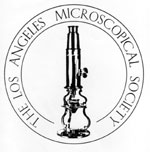 1937
Max A. Erb, acting President (The Microscope Group)
1937
Max A. Erb, acting President (The Microscope Group)
1941 James Smith, first elected President
1947 Major Arthur C. Hurt, Jr., second President
1948 Colonel William D. Fleming, third President
1949 Max A. Erb, fourth President
1950 William Sokol, fifth President
1951 Lloyd Matlovsky, sixth President
1971 John deHaas, seventh President
1974 Gil Mellé, eighth President
A great deal of the history of the Society was shaped by the lives and experience of these men. In turn, the lives of most of these men were shaped by their involvement in the Society. We do justice to these gentlemen by remembering them as individuals and honoring their contributions.
MAX A. ERB, Founder of The Microscope Group and 4th
President
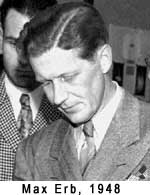 At
the time Max Erb organized The Microscope Group (1938), he was working for the
firm of Carl Zeiss at 728 South Hill Street. Due to WWII with Germany, the Zeiss
operations in the U.S. were closed. Max then went to work at the Frese Corporation
on microscopes for a short period. After this Max Erb and Milton Gray formed
the firm of “Erb & Gray.” For the first few years they were
located at 854 So. Figueroa Street in Los Angeles. They successfully retailed
instruments from a number of popular microscope makers. They even manufactured
a line of their own equipment including the Erb & Gray microscope illuminator
and the Erb & Gray measuring microscope. Max designed the microscope illuminator
with the help of a German optical employee. As a result of his association with
Los Alamos (New Mexico) and the Atomic Energy Commission, Max was contracted
to design and construct a remote-control metallograph which was to be shielded
from radiation. The instrument was delivered to Hanford, Washington in May of
1954. The installation of the metallograph was completed with the assistance
of his senior service man, Ray Tomlinson. He also developed his own portable
refractometer as well as the Visicam photomicrographic camera.
At
the time Max Erb organized The Microscope Group (1938), he was working for the
firm of Carl Zeiss at 728 South Hill Street. Due to WWII with Germany, the Zeiss
operations in the U.S. were closed. Max then went to work at the Frese Corporation
on microscopes for a short period. After this Max Erb and Milton Gray formed
the firm of “Erb & Gray.” For the first few years they were
located at 854 So. Figueroa Street in Los Angeles. They successfully retailed
instruments from a number of popular microscope makers. They even manufactured
a line of their own equipment including the Erb & Gray microscope illuminator
and the Erb & Gray measuring microscope. Max designed the microscope illuminator
with the help of a German optical employee. As a result of his association with
Los Alamos (New Mexico) and the Atomic Energy Commission, Max was contracted
to design and construct a remote-control metallograph which was to be shielded
from radiation. The instrument was delivered to Hanford, Washington in May of
1954. The installation of the metallograph was completed with the assistance
of his senior service man, Ray Tomlinson. He also developed his own portable
refractometer as well as the Visicam photomicrographic camera.
Eventually, Mr. Jack Norcross became associated with the firm and invested funds for expanding the product line into other types of scientific instruments. This included laboratory equipment, precision balances and even the Hitachi electron microscope. In 1951, William Sokol joined the firm just in time to see Milton Gray sell out his share of the business. At that point Mr. Carl McBain left UCLA and became involved with Erb & Gray. In May 1954, Max Erb sold out his interest in the firm and the next day opened a new business, Max Erb Instrument Company on Olympic Boulevard in Los Angeles and at the same time obtained the B&L franchise. Eventually, the new business moved to Burbank, where it is located today managed by Max’s son Ron Erb. Jack Norcross and Carl McBain continued to operate the firm of Erb & Gray. Assisting Max through much of his business matters was his attorney Arthur Hurt, Jr. In the course of time Arthur Hurt served as the second elected President of the Society. Arthur Hurt had a son, Curt, who became an ophthalmologist. Not only was Max Erb the founding father of the Microscopical Society and a successful businessman but he was also an avid gardener. He specialized in the husbandry of orchids.
After Milton Gray left the establishment of Erb & Gray he began distributing machine tools directly out of a large van. This provided some success until he died prematurely of a heart attack, as he weighed over 270 pounds. Milton had a reputation as an excellent machinist but had difficulty with business matters.
JAMES SMITH, 1st President.
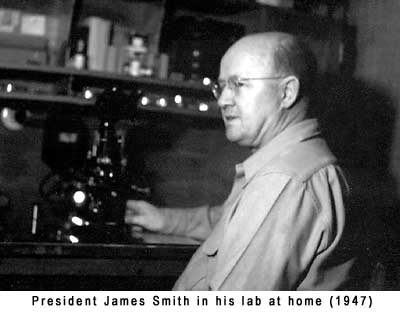 James
Smith was the first elected President of the Society and was well known for
his work with diatoms and photomicrography. I have in my own slide collection
examples of diatoms mounted by Mr. Smith. His mounts are excellent and very
much like those of Mr. W. F. Herzberg and Mr. A. Brigger. I also have samples
of beautifully cleaned diatomaceous material stored in vials with his label.
In addition, we are fortunate to have a number of photographs illustrating his
photomicrographic setup. He was also considered to be a staunch Zeiss man and
was one of the few founding members who owned more than one stand. Like many
enthusiastic microscopists, he converted a portion of his house into a working
laboratory. He also set up a complete machine shop providing adapters and other
parts to the members. His lab was famous among the members and many enjoyable
meetings were conducted at his home.
James
Smith was the first elected President of the Society and was well known for
his work with diatoms and photomicrography. I have in my own slide collection
examples of diatoms mounted by Mr. Smith. His mounts are excellent and very
much like those of Mr. W. F. Herzberg and Mr. A. Brigger. I also have samples
of beautifully cleaned diatomaceous material stored in vials with his label.
In addition, we are fortunate to have a number of photographs illustrating his
photomicrographic setup. He was also considered to be a staunch Zeiss man and
was one of the few founding members who owned more than one stand. Like many
enthusiastic microscopists, he converted a portion of his house into a working
laboratory. He also set up a complete machine shop providing adapters and other
parts to the members. His lab was famous among the members and many enjoyable
meetings were conducted at his home.
Mr. Smith was president of the Hammond Lumber Company in Long Beach but lived in South Pasadena. October 12, 1950, was the last meeting that any of the members of the Society would see Mr. Smith alive. A few days later he died of a heart attack in his office at the age of 55. The date of his passing was October 17, 1950. This was a great blow to the organization since he was, for the most part, responsible for establishing the formal Society out of the Microscope Group. He continually served as an inspiration to his friends and, without any doubt, the Society greatly missed his leadership. In honor of his name, a memorial fund was established and the proceeds were contributed to the Children’s Hospital of Los Angeles.
MAJOR ARTHUR C. HURT, 2nd President
COLONEL WILLIAM D. FLEMING, 3rd President
I am sorry to say that there is not much information available on Major Arthur
C. Hurt, Jr. and Colonel William D. Fleming. The content of the early documents
indicates that both gentlemen contributed significantly to the establishment
and success of the Society. Arthur Hurt was Max Erb’s attorney who lived
in West Los Angeles and was a well-known member of the L.A. Country Club. He
served as the first secretary of the Microscopical Society and meticulously
typed out the minutes and correspondence. It is Mr. Hurt’s signature that
is seen on more of the early documents than of any of the other founding members.
His expertise was in the field of hematology and many of his exhibits illustrated
this subject. Both men presented a wide variety of lectures and demonstrations
illustrating their extensive knowledge and experience in microscopy. It was
during the presidencies of these two gentlemen that the Society experienced
its most rapid and sustained growth (1947 & 1948).
WILLIAM SOKOL, 5th President
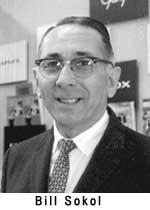 In
my own experience with the Society I can truly say that Mr. William Sokol represented
all that was positive about the early membership. He fulfilled the spirit and
purposes for originally establishing such a Society. He spent hours of his spare
time teaching many members the basics of cleaning and preparing diatoms. He
freely provided materials including rare chemicals used in polarized light experiments.
All of this was supported by his expertise in every format of Photomicrography.
I do not remember a single time when he refused to share his vast knowledge
or valuable experience. His enthusiasm for microscopy never flagged, and even
in the last year of his life he won first prize in the Olympus Photomicrography
contest. The technique used in this prize winning image was developed by a Southern
California photomicrographer named Martin Folb (ca.1976).
In
my own experience with the Society I can truly say that Mr. William Sokol represented
all that was positive about the early membership. He fulfilled the spirit and
purposes for originally establishing such a Society. He spent hours of his spare
time teaching many members the basics of cleaning and preparing diatoms. He
freely provided materials including rare chemicals used in polarized light experiments.
All of this was supported by his expertise in every format of Photomicrography.
I do not remember a single time when he refused to share his vast knowledge
or valuable experience. His enthusiasm for microscopy never flagged, and even
in the last year of his life he won first prize in the Olympus Photomicrography
contest. The technique used in this prize winning image was developed by a Southern
California photomicrographer named Martin Folb (ca.1976).
Mr. Sokol was an active member of the New York Microscopical Society from 1934 until May of 1943. At that time the Society met in the American Museum of Natural History at Central Park West. He participated in the Society’s courses and seminars which were provided by Professor Harry Taub of Columbia University. Prof. Taub, who presented the courses on Crystallography and Chemical Microscopy was later cited by Mr. Sokol as the inspiration for his desire to take color photographs through the microscope. While associated with the New York Microscopical Society, Mr. Sokol was influenced by a number of great microscopists, including Wolfgang Von Zieler who was at that time president of E. Leitz Inc. of New York. Mr. Von Zieler was also president of the New York Microscopical Society in 1939, during the time that Mr. Sokol was active. Another important individual acquainted with Mr. Sokol was Mr. Roy M. Allen, author of “The Microscope.” Mr. Allen conducted seminars on photomicrography and micro-technique, including specimen preparation and rock sectioning.
Mr. Sokol’s continued interest in diatoms was first inspired by Mr. Joseph Burke who for many years worked at the Staten Island Museum. Mr. Burke is a well known diatomist who has devoted most of his life to the study of North American diatoms. He organized the diatom study group for the Society and, in addition to presenting lectures, led the group on regular field trips. Among Mr. Sokol’s memorabilia are a couple of notices from the New York Microscopical Society announcing field trips headed by Mr. Burke. Both notices are from the year 1940 and substantiate his association with that organization. A second organization he belonged to was the American Society of Amateur Microscopists. This Society was founded in 1939 and issued a certificate to its members that was signed by its founder, Dr. Julian D. Corrington. Other early members of the Southern California Microscopical Society also belonged to this organization, including Mr. Zane Price. Before leaving the East Coast, Mr. Sokol studied bacteriology at Newark University.
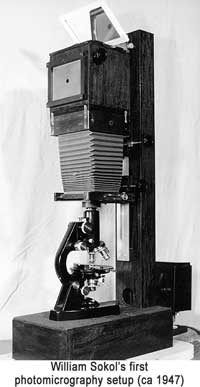 After
establishing himself in California, Mr. Sokol attended the Frank Wiggins Photographic
Trade College which has now become part of L.A. City College. He also attended
special courses in geology at UCLA and optical Mineralogy at USC. After more
than a decade of study and dedication, he had successfully established himself
as a noteworthy microscopist and was well prepared to contribute to the success
of the fledgling Southern California Microscopical Society. Over the years,
Mr. Sokol published a number of scientific papers, all of which were associated
with microscopy. A few examples include: “Art and the Microscope,”
in Functional Photography Magazine, “35mm Photomicrography,” in
Biological Photographic Journal, “Crystal Photography,” in Camera
Craft Magazine and “Mounting and Preparing Diatoms for Microscopic Study,”
(LAMS bulletin).
After
establishing himself in California, Mr. Sokol attended the Frank Wiggins Photographic
Trade College which has now become part of L.A. City College. He also attended
special courses in geology at UCLA and optical Mineralogy at USC. After more
than a decade of study and dedication, he had successfully established himself
as a noteworthy microscopist and was well prepared to contribute to the success
of the fledgling Southern California Microscopical Society. Over the years,
Mr. Sokol published a number of scientific papers, all of which were associated
with microscopy. A few examples include: “Art and the Microscope,”
in Functional Photography Magazine, “35mm Photomicrography,” in
Biological Photographic Journal, “Crystal Photography,” in Camera
Craft Magazine and “Mounting and Preparing Diatoms for Microscopic Study,”
(LAMS bulletin).
The Southern California Microscopical Society was the first scientific organization Mr. Sokol joined after moving to the West Coast in 1943. However, he eventually became active in a number of other groups that represented his interests. In that same year he joined the Biological Photographic Association and became its treasurer, eventually being elected its president. He was also the vice-president of the Camera Chromers of Inglewood, one of many camera clubs with which he was associated. He was also affiliated with a number of notable English Societies, including the Royal Microscopical Society and the Quekett Microscopical Club. His correspondence with Mr. H.A. Dade led to his application to the Quekett. Mr. Dade, who at the time was assistant director of the Commonwealth Mycological Institute, Kew, sponsored Mr. Sokol’s application. As a result, Mr. Sokol joined the Quekett in April of 1954.
As we learned earlier, the microscope strongly influenced the employment decisions of many of the founding members. These circumstances were also true in the case of Mr. Sokol, however, it did not start out that way. In the late 1920’s when Mr. Sokol lived in New Jersey, he was employed as a bus driver. Sometime in 1931 or 1932 he became a passenger traffic agent for the Pennsylvania Railroad in New York City. He remained in this position until 1943 when he moved to California. It was during the time he was employed in New York that he organized a camera club among his friends in the railroad business. There remains today a photograph of Mr. Sokol and his fellows from the station proudly exhibiting their photographic work.
After moving to California, Mr. Sokol’s first job was with the Pacific Railroad Company as a ticket agent. He spent the next nine or ten years with the railroad until May of 1952, when he began working for the Erb & Gray Instruments Co. He was administrative director of this company, and as such acquired a great deal of valuable experience.
Many years earlier, in 1929, Mr. George Lory established the Los Angeles Scientific Instrument Company (LASICO)* See Footnote. Herman Adler was a traveling representative for E.Leitz, Inc. He persuaded Mr. Lory to expand his business and establish LASICO, and hire Mr. Sokol as the Sales Manager. So after four years with Erb & Gray, Mr. Sokol was hired by Mr. Lory of LASICO, where he was employed for 16 years before retiring in 1971 at the age of 67. However, it seems that he spent a short time working at the Max Erb Instrument Co. in Burbank, but in a limited capacity. He spent a total of 20 years selling scientific instruments.
Mr. Sokol was elected president of the Southern California Microscopical Society on July 13, 1950. In his notes he stated that he was also the vice-president for a short period. I have not been able to determine at what time or under which president he served in this capacity. In the 1950’s, the records were not well kept and are not clear enough to make concrete determinations. As mentioned earlier, Mr. Sokol served as chairman of the Demonstration Committee for the 1948 Exhibition. He was elected secretary-treasurer on March 23, 1948, at the same time Colonel Fleming was elected president and Milton Gray, vice-president. A few years later, after assuming the office of president, he continued carrying out the duties of secretary. In 1951, when Lloyd Matlovsky became president, he asked Mr. Sokol to continue as secretary-treasurer. This dual role lasted until late 1952. In 1951, during Mr. Sokol’s presidency, the most notable speaker was Mr. George Needham. Mr. Needham was president of the San Francisco Microscopical Society and the author of “The Practical Use of the Microscope.” This book has come to be known as the “microscopist’s bible.” Mr. Needham’s lecture concerned the application of phase microscopy and was illustrated with Kodachrome slides. He was invited to Los Angeles by Mr. Bert Scott, a SCMS member, who had been corresponding with Mr. Needham.
LLOYD MATLOVSKY, 6th President
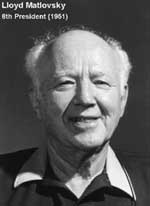 After serving in the U.S. Navy as an optical engineer, Lloyd Matlovsky became
affiliated with the University of Southern California. As mentioned above, he
followed Mr. Sokol as president in October of 1951. By this time, many of the
activities of the Society were combined with those of the Biological Photographic
Association. As the members migrated to the BPA, there were no sustained efforts
to maintain the structure and offices of the Microscopical Society.
After serving in the U.S. Navy as an optical engineer, Lloyd Matlovsky became
affiliated with the University of Southern California. As mentioned above, he
followed Mr. Sokol as president in October of 1951. By this time, many of the
activities of the Society were combined with those of the Biological Photographic
Association. As the members migrated to the BPA, there were no sustained efforts
to maintain the structure and offices of the Microscopical Society.
This brings to an end the account of the first historical period of the Society. The revived Society of the early 1970’s was brought about by Prof. John deHaas and should be the subject of future documentation.
SOUTHERN CALIFORNIA MICROSCOPICAL SOCIETY LIST
OF MEETINGS 1941-1952
Dates, Speakers, Subjects and Locations
03-06-1941 James Smith, Discussion relative to the organization. Levy’s Restaurant.
03-27-1941 John W. Budd, Transmitted light and photomicrography. Residence of Dr. J.W. Budd.
04-24-1941 Max Erb, Fluorescence Microscopy. Hematology Dept, Children’s Hospital.
05-15-1941 Max Erb, Microscopical Publications. Hematology Dept of Children’s Hospital.
06-0?-1941 James Smith, Business meeting, Mr. Rumann exhibited a motion picture. Hematology Dept of Children’s Hospital.
05-15-1946 Arthur C. Hurt, Report on the state of the Society, Business meeting. L.A. Athletic Club.
06-25-1946 Lloyd Matlovsky, Exposure control in photomicrography, Forensic Lab explained. W.W. Harper’s Lab.
07-23-1946 John W. Budd, Research on cancer, Mr. Hurt reported on Microtomy. L.A. Tumor Institute.
08-27-1946 W. Merrill & W. Naylor, The electron Microscope. The Research Laboratories of Union Oil Company of Calif.
09-23-1946 Lloyd Matlovsky, The Measurement of Lens Apertures. L.A. County General Hospital.
11-26-1946 James Smith, Discussion on photomicrography. Home of Mr. James Smith.
01-28-1947 James Smith, Personal exhibits. L.A. County Museum of History, Science and Art.
03-25-1947 Max Erb, Elections, Practical Microscopy, Mr. Gray on Construction of Lens Mounts. L.A. County Museum of History, Science and Art.
04-22-1947 Arthur C. Hurt, Mysteries of Plant Life, and a talk on “Spherical & Chromatic aberrations. L.A. County Museum of History, Science and Art.
05-27-1947 James Smith, Cleaning of Fossil Diatoms & Demonstration of mounting techniques. L.A. County Museum.
09-30-1947 Arthur C. Hurt, Mounting Media. L.A. County Museum.
10-28-1947 Col. W. Fleming, Mounting Media of High Refractive Index. L.A. County Museum.
11-25-1947 Harry Baskerville, Separation Negative Techniques. L.A. County Museum.
01-27-1948 William Sokol, 1st annual Exhibition. L.A. County Museum, Exposition Park, Junior section.
02-0?-1948 L.A. County Museum of History, Science and Art.
03-23-1948 F.R. Abbott, B&L Phase Microscopy, elections. L.A. County Museum of History, Science and Art.
04-20-1948 Milton Gray, Demonstration of visicam camera, also Mr. G. Rhode of Erb & Gray present. L.A. County Museum, Exh Park. Joint session with BPA.
04-27-1948 Colonel W. Fleming, Selecting used objectives, tests. L.A. County Museum of History, Science and Art.
06-03-1948 Dr. Oscar W. Richards, Phase Microscopy, American Opt. Co. L.A. County Museum of History Science and Art. With the BPA.
09-28-1948 Arthur C. Hurt, Review of Microscopical Illumination. Mr. C.D. Sebo, Automatic cameras. Viewed film-Pasteuris Legacy. L.A. County Museum of History, Science and Art. Joint with the BPA.
10-26-1948 Col. W.D. Fleming, The Maltwood finder. Mr. Gray on the Mechanical adjustment of the microscope. L.A. County Museum of History, Science and Art. Exp Park.
11-23-1948 Lloyd Matlovsky, Photomicrography in Color. L.A. County Museum of History, Science and Art. Exp Park.
01-20-1949 James Smith, Symposium on Photomicrography. Illumination. Mr. L. Matlovsky on exposure. With the BPA. L.A. County General Hospital.
05-26-1949 William Sokol, Business meeting. L.A County Museum.
06-09-1949 Arthur C. Hurt, Polarized Light, Mr. Ed Lowe on pol slide making. L.A. County Museum, Exp Park.
07-0?-1949 William Sokol, Business meeting. L.A. County Museum, Exp Park.
08-0?-1949 Alice Scott, Quick freezing tech. L.A. County General Hospital.
10-27-1949 Max Erb, Latest in Modern Microscopes. Erb & Gray Instrument Company.
12-01-1949 Bill Jones, Preparing metals for microscopic examination. Smith-Emery Corp. L.A.
01-12-1950 Max Erb, Zeiss equip, & the OrthoPhot Camera. Erb & Gray Inst. Co
02-09-1950 James Smith, On illumination. Erb & Gray Inst. Co.
03-09-1950 Max Erb, Mirror type lens by B&L. Erb & Gray Inst. Co.
04-02-1950 American Opt. Phase Microscopy. Erb & Gray Inst. Co.
05-09-1950 Bill Jones, Photomicrography & metals. Smith-Emery Corp. on Crocker St. L.A.
06-08-1950 Bill Jones, Polarizing microscopy. Smith-Emery Corp.
07-13-1950 James Smith, Mr. Sokol elected as President. Home of Mr. Smith, So. Pasadena.
08-10-1950 James Smith, 10- watt Zirconium arc Lamp. Home of Mr. Smith, So. Pasadena.
09-14-1950 James Smith, Magnify ribbon filament for illumination, Use of Abbe condenser. Smith-Emery Corp.
10-12-1950 H. Magg & L. Matlovsky, Galileo Phase Stand & Zirconium arc lamp. Home of George Lowry, Silver Lake.
11-09-1950 Dr. Kohler, The Scopacon, tissue slides of malignancies. St. Vincent’s Hospital L.A.
12-14-1950 L. Matlovsky, Auction and Christmas Party. Smith Emery.
01-11-1951 Russell Neil, Application of radioactive isotopes. The Tumor Institute. Hope St. L.A.
02-0?-1951 William Sokol, Diatoms & polarized slides. Home of W. Sokol.
03-0?-1951 Bill Jones, Smith-Emery Corp.
0?-0?-1951 George Needham, Application of Phase microscopy, blood platelets under phase. Home of Mr. Bert Scott, Glendale.
10-0?-1951 G. Brauer & W. Sokol, Into to Polarized Light, slide making tech, photomicrography of Pol light. Elect of L. Matlovsky. Dues reduced to $1.00 a year. Home of George Brauer.
11-08-1951 L. Matlovsky, Exposures in Photomicrography. L.A. County General Hospital.
01-10-1952 William Sokol, Inspect the plant & equipment of the L.A. Scientific Inst. Co.
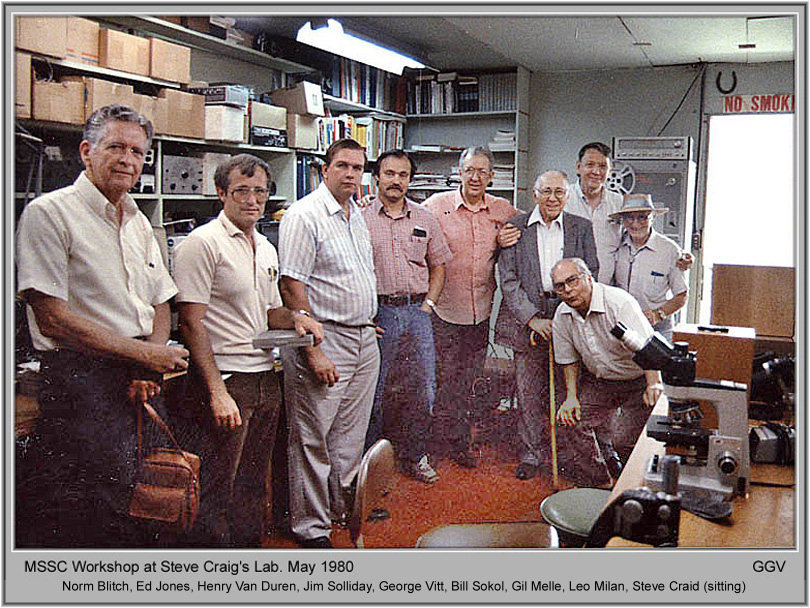
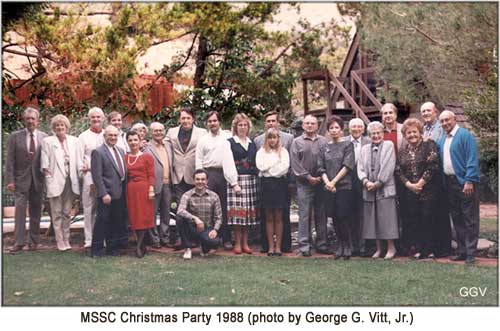
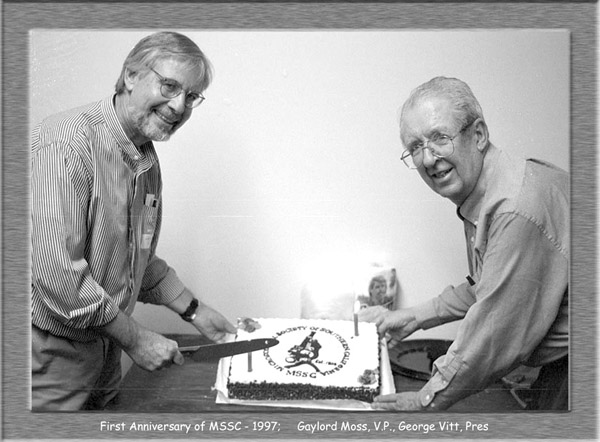
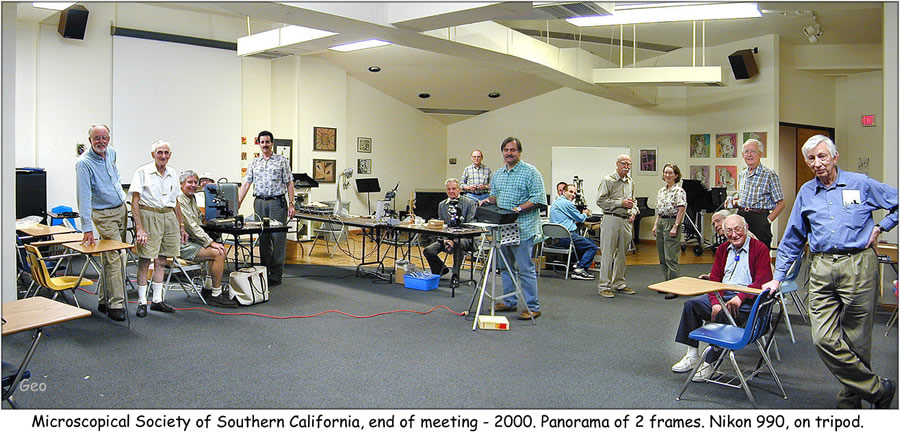
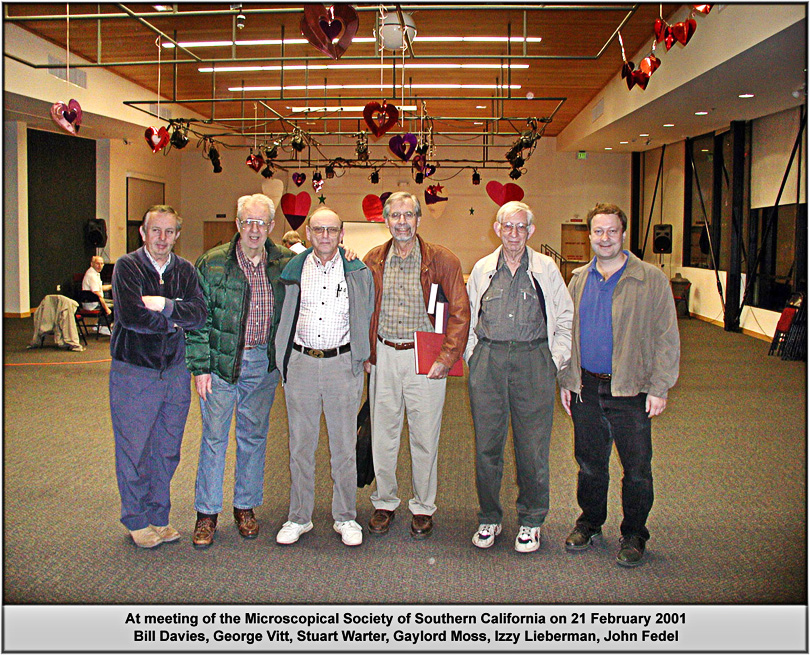
WHAT'S
NEW? / MSSC HOME PAGE / MSSC
HISTORY / PROGRAM SCHEDULE /
ITEMS FOR SALE / NEWS
AND EVENTS / ARTICLES & RESOURCES / CONTACT US / HOW TO JOIN / LINKS / MEMBERS
AREA

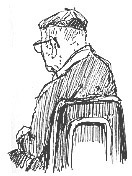
Cartoons by Nirvan Mullick
Site created and maintained by Leonie
Fedel
Please email comments
© MSSC